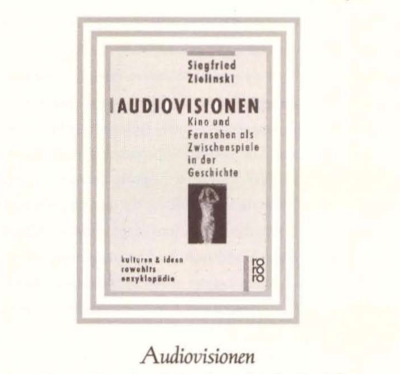Because of the forced integration of film and television into Hivision, theories praising the uniqueness of these media in the past seem to have missed the boat almost completely. To salvage what can be from their hopeless situation, the West Berliner Siegfried Zielinski proposes writing an'integrated media history'. Under the common denominator of ‘audio visions', he goes so far (in his book of the same name) that he even includes the history of automobile traffic. Communication science must really be at the end of its rope!
In his audio visions, Zielinski has succeeded in cooking up a special theoretical brew. He's remained loyal to the critical idea of the 'culture industry’ which can be found in Horkheimer/Adorno. His tone is accusing when he speaks of occupation of hearts and minds and the destruction of space and time by the media s violence. He supplements this moving Marxism with some more recent English material, in which Raymond Williams is the central figure in the background. While he has little use for the cynical 'discourse of the disappearance' coming from France, he actually joins ranks with Virilio, when it comes to the perception war, for example. He feels closest to the work of Alexander Kluge and Jean-Luc Godard, two film makers who're on a good footing with TV and who also manage to write theoretical essays about both kinds of media when they're not making films. Zielinski’s ideal can be found in Kluge’s ‘classical publicness' in which people practice their communicative arts collectively, instead of just sitting at home in front of the tube and becoming more and more alienated.
As television theory still doesn't amount to much world wide, Zielinski has set his sights first and foremost on cinephiles and their myths about film history and reception. He begins his labours of reconstruction from an imaginary point in the future, when TV and film have merged into one, and looks backwards towards the middle of the nineteenth century. He wants to show that the series of inventions which ultimately resulted in film and TV were closely related and had much in common. He doesn’t introduce any new material here, but, rather, simply rearranges the existing historical writings. As interesting and convincing as this polemical use of historical sources may be, it doesn't make for any world shaking passages. Well, a rewrite of history just goes with the beginning of a new phase, we’re left to conclude.
Zielinski does, however, make completely plausible the idea that we're at the beginning of a new ‘audio-visual discourse’. In the fourth and last part of his book, he makes an inventory of the approach to the ‘multifunctional monitor' in the late eighties. This wasn’t only a result of the development of HDTV, but also of the changed way ofrelating to the media, which is encroaching upon the outdated forms of TV and film. They’ve been forced to give up their fixed time- and space-coordinates. The viewers have become mobile and flexible, they use walkmen, watchmen, and video recorders to turn the media to their own advantage.
Zielinski closes with a call for the making of filmic essays and live broadcasts, which use new techniques, but without image cliches, sex or violence, to combine experiment with an eye for reality. He refers to Peter Greenaway and Derek Jarman, German documentary film makers like Bitomsky, Costard, Farocki, Krieg and the Americans Blumberg and Garrin. At least, they come out openly for the new techniques and aren't as hypocritical as Wim Wenders, who paints a picture of TV as cultural barbarism' and simultaneously uses the newest HD techniques in editing his film Himmel über Berlin.
Mediamatic Magazine vol 5#3 1 Jan 1990
Audiovisionen
Kino und Fernsehen als Zwischenspiele in der Geschichte
Siegfried Zielinski, Rowohlt Taschenbuch Verlag (pub)
Reinbek bei Hamburg 1989,2480 ISBN 3 499 55489 5,
German text, pp.318, DM24.80
